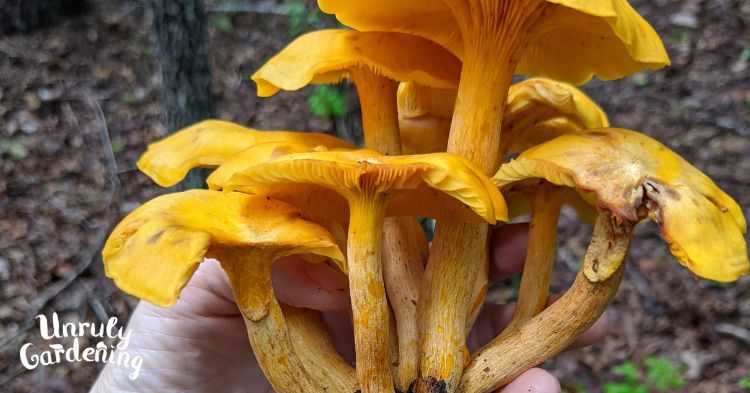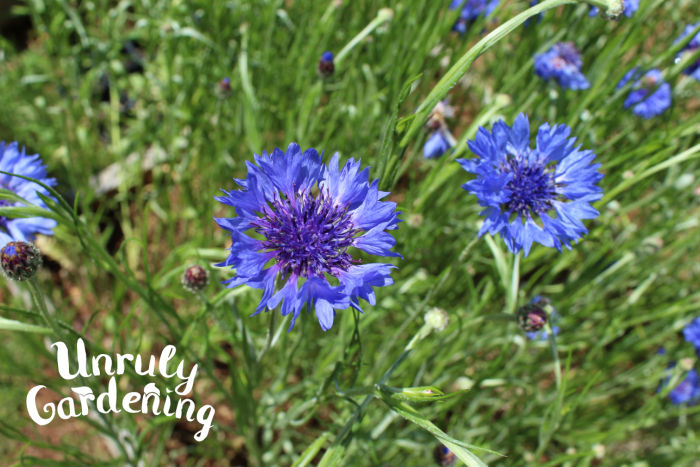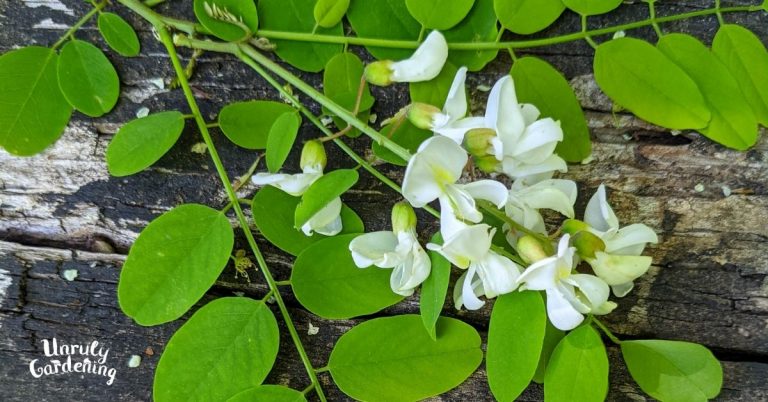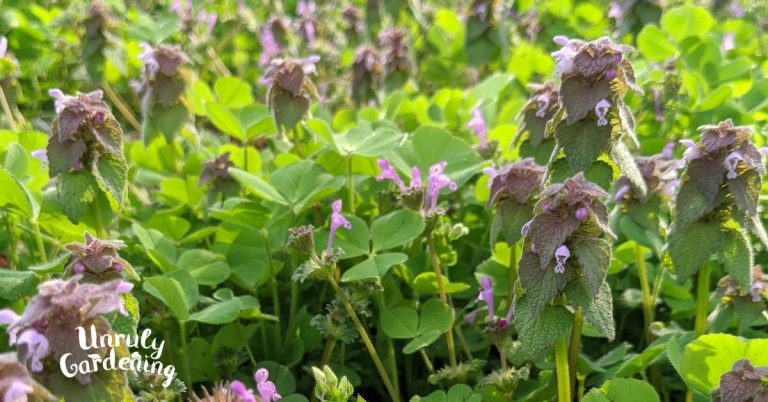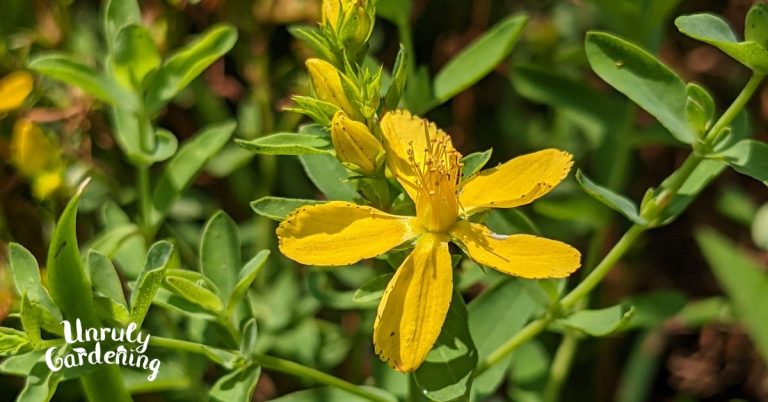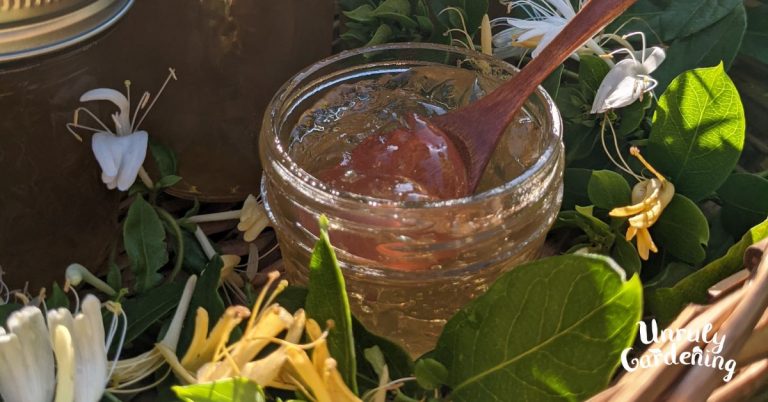Foraging Violets: How to Identify, Harvest & Use!
Learn how to identify and forage for wild violets, plus how to harvest, preserve, and use them. Often considered a backyard weed, violets provide value to native butterflies, bees, and wildlife, and they offer food and herbal benefits for humans too!

Foraging wild violets is an easy and fun springtime activity! Here’s how to make sure you have the right plant. While you’re here, be sure to check out our violet recipes below to give some starting ideas of how to use your harvest.
Related Article: How to Grow Your Own Sweet Violets from Seed
Identifying Violets
Wild violets belong to the family Violaceae, the same family in which you can find garden pansies and violas. (See our related article about growing pansies and violas from seed for more about those plants.)
There are about 78 species of wild violets found in North America, plus even more hybrids – see the Flora of North America website for more details.
Since they’re common backyard plants (or weeds, depending on who you ask!) it’s quite possible that you may also run across common violets (Viola sororia) or sweet violets (Viola odorata) growing right around your own home.

Flowers
The most distinguishing feature of common and wild violets are the pretty, edible flowers. The nodding flowers are held up on a slender stem (a leafless stalk) and have five uneven petals. Most of the time the blooms are purple, but there are also yellow and white variations, or white and purple variations, such as confederate violets.
A note about yellow violets:
Many foragers and herbalists avoid eating or using yellow violets, because they may contain a higher amounts of natural plant compounds (saponins) that makes them taste bitter, and which can upset your stomach. Others say they’re okay to use, but do a taste test first; if a violet flower tastes unpleasantly bitter, don’t use them. Personally, if I had yellow violets growing where I live, I’d definitely try them out externally, but would be cautious about using internally.

Leaves
Violets have heart shaped leaves. Depending on the variety, they may have rounded toothed edges; some may be more rounded heart shaped, while others are longer and narrow hearts. The leaves grow in a low basal rosette; they don’t get very tall at all.
Here’s a photo of the front of a violet leaf:

And the back view of a violet leaf:

Violet Lookalikes
While the flowers are used as key identifiers, the heart-shaped leaves can resemble other plants, some toxic. So if you’re a beginner forager and aren’t 100% certain you’re dealing with a violet plant, then you should only harvest violets when they are in bloom. (You can also grow your own violets from seed or buy plants, and that way you can be certain you’re dealing with the correct plant.)
Here are a couple of plants that could resemble violet leaves when you’re out foraging in early spring.

Violet Lookalike 1: Lesser Celandine (Ficaria verna)
Lesser celandine, also known as fig buttercup, is a low growing plant whose leaves closely resemble violet. The flower is much different though. Lesser celandine’s blooms are yellow with 8 to 12 petals.
Not only is it toxic to humans in most stages, it’s considered a weedy and invasive plant, originally from Europe, parts of Northern Africa, and Asia. You’ll find it aggressively spreading via bulblets and tubers throughout North America. The real problem is that it forms thick plant mats that choke out our lovely native spring ephemeral flowers, such as bloodroot, trillium, trout lily, Virginia bluebells, and more.
Whenever possible, don some gloves and try to remove lesser celandine from your yard or land.

Violet Lookalike 2: Kidneyleaf Buttercup (Ranunculus abortivus)
Also called little leaf buttercup, this plant is native to all of the lower 48 states + Alaska. All parts can be toxic and could even trigger some skin sensitization in some. This is a plant that’s best left alone to be admired.
Its basal leaves look a lot like violet, and you might find them growing side by side, as in the photo example above. Once it blooms, you can clearly see the tiny yellow flowers looks nothing like violets, but it’s good to be aware of its possible nearby existence when foraging.

Violet Lookalike 3 – Garlic Mustard (Alliaria petiolata)
Garlic mustard (Alliaria petiolata) grows in rosettes of green and could possibly be confused for wild violets before they bloom.
The difference is that garlic mustard leaves are more crinkly looking, when crushed or torn they smell kind of garlicky (though personally I don’t think they smell like the pleasant kind of garlic!) and they have a distinctive rounded “dipped-in shape” where the leaf meets its stem. See the below photo for a closeup:

While garlic mustard is edible, it’s also an aggressive grower and invasive plant in North America. It’s a huge threat to biodiversity and native plants in general.
It grows well in early spring weather, blocking sunlight and hogging nutrients so that our valuable early spring plants – such as bloodroot, trillium, toothworts, and more – don’t have a chance at growing and reproducing. Garlic mustard’s roots also put off a chemical that upsets the underground network of soil fungi.
If you spot a cluster of garlic mustard and it hasn’t gone to seed yet, pull it out by the roots and ideally, throw it in the trash, or at the very least, shake the dirt from the roots and lay the plant somewhere so the roots will dry out and die. (If it has already seeded, it’s best to leave alone or you’ll accidentally spread the seed even further.) Never plant or grow garlic mustard on purpose, and never compost the plants.

Violet Lookalike 4: Golden Ragwort (Packera aurea)
Golden ragwort (Packera aurea), also called Golden Groundsel, is a perennial native plant that attracts native bees, bugs, and butterflies. It’s a good plant to have around, however, the leaves have some toxins in them, so you definitely don’t want to confuse it with violet leaves!
It has yellow flowers that are daisy-like and look nothing at all like a violet flower, so once it blooms, you’ll be able to easily tell them apart.

Foraging & Harvesting Violets
Now that you know what to look for, use these tips to help you find violets growing around you!
The usual foraging basics apply to violets too: Only collect from areas you have permission to access, don’t harvest from areas right next to roads, or ones that have been sprays with herbicide or pesticides, or places that are frequently used as an animal bathroom spot. For every flower or leaf you collect from a plant, leave most of the rest behind.
Threatened & Endangered Violets
The USDA maintains a list of protected violets that are threatened or endangered. Be sure to check this list and make sure your violets aren’t on there, so you know not to pick or use them.
These include:
- Northern Bog Violet (Viola nephrophylla Greene)
- Downy Yellow Violet (Viola pubescens Aiton)
- Sweet White Violet (Viola blanda Willd. var. palustriformis A. Gray)
- New England Blue Violet (Viola novae-angliae House)
- Striped Cream Violet (Viola striata Aiton)
- and 39 more!

Where to Look
The easiest and best place to look is in your own backyard, especially spots that get partial shade. If you live in a older neighborhood, or know someone who does, you might just find common blue violet or sweet violets growing at the edges of lawns, in empty garden beds, or around house foundations.
Violets also grow out in the wild, around streams and creek banks, and in woodland or field edge areas. However, some wild populations are very limited, so you want to 100% identify those types of violets and ensure that they’re plentiful and not a threatened species before picking.
When to Look
Violets bloom in cooler weather – usually very late winter to early spring. Here in zone 7a, we see the first violet flowers in early March.
A few random flowers will also appear in fall, when the weather turns cooler, but this can’t be counted on from year to year.

How to Harvest
Violet flowers are easy to collect, just a little time consuming! (It helps to have an enthusiastic kid or friend who is willing to pitch in!)
Pick each flower one by one from plants that aren’t covered with dirt or sandy soil. Collect in jar or container that can easily fit in the fridge, in case you can’t process your violets right when you get home.
Which Parts of the Violet Are Edible
Both violet leaves and flowers are edible. Young leaves are best, while they’re nice and tender. Violet flowers are good as long as they aren’t browned or wilted. Both should be enjoyed in moderation, since they can have a laxative effect.
Most people don’t eat violet stems because they’re tougher. You should not eat the roots of violets; they will make you sick to your stomach and should be avoided.

How to Freeze Violet Flowers
Freezing is my favorite way to preserve an abundance of fresh violet flowers. You can use the frozen violets in the year to later make jelly or soap. (Note that freezing and thawing brings out a lot of moisture content, so frozen violets aren’t suitable for infusing in oil.)
To freeze, you can spread the violet flowers on a parchment lined baking sheet and allow them to freeze completely. Remove from the sheet and carefully store in freezer bags or containers.
My favorite (i.e. lazy) method is to just fill a freezer bag partly with fresh violet flowers, then turn the bag on its side and shake/spread the contents into one flat layer. Seal up the bag and lay it in your freezer, maintaining that laying-flat effect.
Frozen violets will keep for several months, or as long as they don’t lose their color and/or develop freezer burn.

How to Dry Violet Leaves & Flowers
To dry violet leaves or flowers, spread them out in a single layer over a drying screen, clean dishcloth, or paper towels. Allow them to air dry, turning the leaves over every day or two. Depending on your climate and room temperature, the violet leaves should be dried within 4 or 5 days, and the flowers will likely dry even quicker.
If you live in a very humid climate, you may need to use a dehydrator. To dry violet leaves in a dehydrator, spread them out on dehydrator screens and dry at 90 to 95 degrees F for about 4 or 5 hours. Start checking at three hours in. Crumble a dried piece between your fingers to make sure it’s completely dry.
Store your dried violet leaves and/or flowers in brown paper bags, or in a jar out of direct sunlight. They should stay fresh for about 9 to 12 months, or as long as they still contain some color. Faded, drab herbs have usually lost their potency and should be composted.

Uses & Recipes for Violet Flowers and Leaves
Violet flowers are edible and safe to eat!
(This is also true for pansy and viola flowers which can be used for food purposes. Remember though that African Violet is not the same thing and is not edible.)
The pretty purple blossoms of violets can be used to make beautifully colored jellies, syrups, and vinegar. They can also be crystallized or candied, or used to garnish drinks, salads, ice cubes, or cupcake tops.
The leaves are used in herbal medicine; they contain soothing components and mucilage which helps calm and cool inflamed conditions such as eczema, chapped lips, sore throats, and mild coughs.
Don’t eat the roots as they’re an emetic. (Something that makes you vomit; you will feel very sick if you eat violet roots!) This is a good place to note that eating too many violet flowers can have a laxative effect, so enjoy violet containing foods in moderation!

Violet Flower Jelly
To make this beautiful and tasty jelly recipe, you’ll need:
- 2 cups fresh violet flowers
- 3 cups boiling water
- 2 tbsp lemon juice
- 2 1/2 cups sugar
- 1 package low sugar needed Sure-Jell pectin. (the 1.75 oz pink box)
The finished violet jelly is one of our favorites! The taste and flavor reminds us a lot of grape jelly, but even better.
Violet Leaf Field Poultice
One of my favorite uses for violet leaves is a simple field poultice. If you’re out and about enjoying a beautiful spring day, and then happen to get stung by a bee, or get a splinter or thorn in your finger, violet leaves can help you out!
Just pick a few leaves and mash them with your fingers (or chew them up a little with your teeth), then place the resulting leaf mash over your sting, splinter, or thorn. If you have a bandaid or strip of cloth, that will help hold it in place, if not, you’ll have to make do with your fingers holding it on for a while.
Violet leaves have soothing, cooling, mucilaginous properties that will help the inflamed area feel better.
Violet Flower Vinegar
This is truly one of the most beautiful vinegars you can make, plus it’s actually useful!
Here are 5 ways to use it:
- Vinegar baths
- Wasp stings
- Sunburn
- Hair rinse
- Violet vinaigrette
Find out how to make it and use it in my article, Five Uses for Violet Vinegar, over at the Nerdy Farm Wife site.

Lip Balm
Violet leaves make a great addition to lip balm. Here’s our recipe that incorporates several spring green herbs (violet leaf, chickweed, and purple dead nettle) to create an extra soothing lip balm.
You could also just use all violet leaves to make this recipe!

Salves, Soaps & More Uses!
For even more ways to use violets, plus a free printable violet reference sheet, be sure to check out this article I wrote at The Nerdy Farm Wife website:
10+ Things to Make with Violets
Even More Ideas:
Violet Flowers are also featured in my daughter’s Spring Cleaning Face Wash tea that she created as a teenager for clearer skin.
Grow Forage Cook Ferment has a beautiful looking Wild Violet Soap recipe, while Learning and Yearning has a recipe for Violet Infused Aloe Gel, Hearth & Vine has a beautiful Wild Violet Syrup recipe, and Homestead Lady has a yummy looking violet gelatin recipe to try out.
References & Further Reading
Cech, Richo. Making Plant Medicine. Williams, OR: Horizon Herbs, 2000. Print.
USDA, Natural Resources Conservation Service, Threatened & Endangered Plants Database. Accessed March, 2023.
Our articles are for information and idea-sharing only. While we aim for 100% accuracy, it is solely up to the reader to provide proper identification. Be sure to seek out local foraging classes and plant walks, and invest in foraging guides suitable for the area you live in, since some wild foods may have adverse effect.


